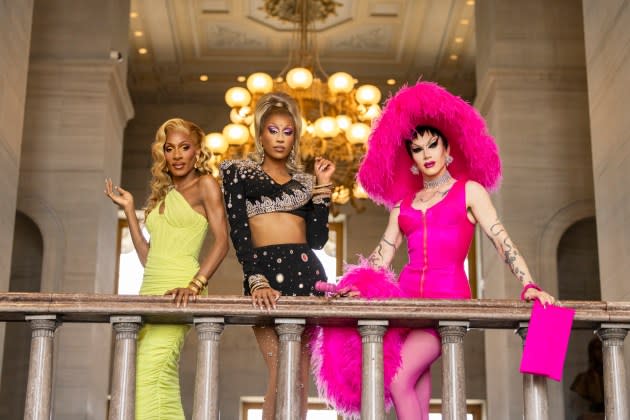HBO Makeover Show ‘We’re Here’ Takes on Drag Bans With a Recast Season 4: TV Review
- Oops!Something went wrong.Please try again later.
- Oops!Something went wrong.Please try again later.

The premise of the drag makeover show “We’re Here” is that queer liberation hasn’t extended as far as it could. For three seasons, a group of “RuPaul’s Drag Race” alumni have traveled to small towns throughout the country, helping members of the local LGBTQ community assert their identity and visibility through gender-bending performances. But even a project that deliberately targets places where gay and trans people might feel cut off from a sense of camaraderie — many locations are scattered throughout the South and Midwest, with occasional detours to California and Hawai’i — didn’t anticipate their own art form coming under such intense public scrutiny.
“I would never have predicted that, four seasons later, it’s actually harder to be out and proud,” Priyanka says in last month’s premiere. The “Canada’s Drag Race” winner is one of several new faces this season, which bids farewell to Bob the Drag Queen, Eureka O’Hara, and Shangela in favor of a complete cast turnover. (Shangela, legally known as Darius Pierce, currently faces multiple accusations of sexual assault, but her voice appears in a baton-passing introduction that implies there’s no bad blood in the previous hosts’ departure. Pierce denies the allegations, which go unmentioned in “We’re Here.”) But the new episodes also pick up on a thread that began with Season 3’s finale, a two-part spotlight on Ron DeSantis’s Florida and its widely condemned slate of anti-LGBTQ legislation. “We’re Here” has leaned into this structure with a season that’s more serialized, allowing an extended focus on both its local subjects and the increasingly prejudiced political environment they’re trying to live their lives within.
More from Variety
'We're Here,' 'Beauty and the Beast: A 30th Celebration' Are Early Emmy Winners
'We're Here' Adds 'Drag Race' All-Star Latrice Royale as New Host for Season 4 (EXCLUSIVE)
Priyanka is joined by Sasha Velour, Jaida Essence Hall and Latrice Royale, all graduates of TV’s leading drag queen competition show. (Other than mining it for cast, “We’re Here” is unaffiliated with MTV’s “Drag Race,” and airs on Warner Bros. Discovery’s HBO, and not a Paramount Global network. This leads to some amusingly awkward moments in which the “We’re Here” queens allude to past TV experience without invoking that other show by name.) Though the production team, led by creators Stephen Warren and Johnnie Ingram as well as director Peter LoGreco, remains intact, the six-episode season splits itself into two halves rather than a half-dozen individual parts. The first arc, which concluded last Friday, takes “We’re Here” to the battlefront of the culture wars: Tennessee, a state that attempted to severely restrict drag in a 2023 law that was quickly suspended via injunction, though the statute remains under appeal in federal court.
The “We’re Here” crew sets out to stage a drag show in Murfreesboro, a small city that responded to the drag law’s suspension by passing a so-called “decency ordinance,” an ambiguously worded law that put the city’s annual Pride celebration in jeopardy. (Following litigation by the Tennessee Equality Project and ACLU, the ordinance has since been repealed.) The lead queens show up to public meetings and permit applications in full drag, often expressing worry they could potentially be arrested. Some of this drama may be played up for the cameras, with drag deployed as political confrontation and law enforcement an ambiguous threat. But these scenes are an intensified version of an all-too-real dynamic — not unlike how drag reveals the absurdity of typical gender expression by cranking it up to 11.
If Priyanka, Jaida and Sasha are bringing the situation in Tennessee to a national audience, their new drag children live through it every day. In addition to political context, the expanded canvas of Season 4 allows more room for these compelling characters: a trans woman finally exploring her intersex identity; an openly gay ex-mayoral candidate who once had a bullet fired into his home; a Christian musician who wants to show support for his queer and trans children; a queer wrestler who wants to carry the confident flamboyance of their ring persona into everyday life. Not all of the locals featured can fully commit to going onstage; a former professional baseball player backs out of the show, fearing it could hurt his new music career. Those that do stick around for the duration are rewarded with warm, empathetic portraits, not to mention professional-grade production quality for their drag debuts.
Even with the extra runtime, “We’re Here” doesn’t focus much on the mechanics of these transformations. (For that, there are plenty of Werk Room scenes that get into the dos and don’ts of tucking.) Instead, the show goes deeper into the challenges its subjects face, whether in their day-to-day existence or in a larger social struggle. In the season’s back half, set in Bartlesville, Oklahoma, “We’re Here” even gets into internal divisions within queer advocacy when a local pride group expresses concerns over a TV production potentially inflaming existing tensions around the queer community. The previous year, a drag performance during Bartlesville Pride had sparked aggressive backlash from locals.
Unsurprisingly, “We’re Here” doesn’t give much credence to these critiques of its approach. (The queens have a point when they argue a pride organization that fails to fight for visibility is undermining its own purpose.) The meta debate is still an example of what “We’re Here” can add to what’s otherwise a “Queer Eye”-style comfort procedural with its change in focus and format. The world has made drag, already an implicit challenge to gender norms and social conformity, into even more of a lightning rod. “We’re Here” has adjusted accordingly.
New episodes of “We’re Here” Season 4 premiere Sundays on HBO and Max at 9 p.m. ET.
Sign up for Variety’s Newsletter. For the latest news, follow us on Facebook, Twitter, and Instagram.
